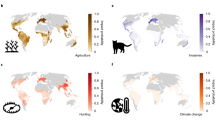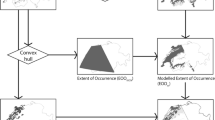Abstract
The criteria for classification set down in the new system of the IUCN Red List categories were applied to national distribution areas. Application of the new criteria to national distribution areas calls for an estimate of the rate of immigration. Classification was applied to the Italian autochthonous terrestrial vertebrate species that reproduce in Italy (Amphibia, Reptilia, Aves and Mammalia). Species with both marine and land habitats were included, but Cetaceans were excluded. Eighty-eight species of the autochthonous species that reproduce in Italy were classified in the threatened categories at the national level. One of the main purposes of the present classification of the risk of extinction in national distribution areas is to provide the information needed to define global conservation priorities of species present on national territory. The species nationally and/or globally endangered or at lower risk were grouped into four priority classes, on the basis of their reproductive phenology on national territory and the size of temporarily present contingents. Of the 551 species present regularly or seasonally on Italian territory, 149 (27.0%) are in the initial indicative list of conservation priorities.
Similar content being viewed by others
References
Amori, G., Angelici, F.M., Frugis, S., Gandolfi, G., Groppali, R., Lanza, B., Relini, G. and Vicini, G. (1993) Checklist delle Specie della Fauna Italiana. Bologna: Calderini.
Avery, M., Wingfield Gibbons, D., Porter, R., Tew, T., Turcker, G. and Williams, G. (1995) Re-vising the British Red Data List for Birds: the biological basis of UK conservation priorities. Ibis 137, 232–9.
Boitani, L., Corsi, F., Angelici, F.M., Penteriani, V. and Pinchera F. (1993) Banca Dati della Fauna Terrestre Italiana. Roma: Ministero dell'Ambiente.
Brichetti P. and Cambi, D. (1982) Osservazioni sulla lista rossa degli uccelli italiani. Avocetta 6, 201–3.
Bruno, S. (1983) Lista rossa degli anfibi italiani. Riv. Piem. Storia Nat. 4, 5–48.
Bruno, S. (1986) Tartarughe e Sauri d'Italia. Firenze: Giunti Martello.
Burton, J.A. (1984) A bibliography of red data books. Oryx 18, 61–4.
Collar, N.J., Crosby, M.J. and Stattersfield, A.J. (1994) Birds to Watch 2. Cambridge: Birdlife International.
Corbett, K. (1989) Conservation of European Reptiles & Amphibians. London: Croom Helm.
Frugis, S. and Schenk, H. (1981) Red List of of Italian birds. Avocetta 5, 133–41.
Gardenfors, U. (1996) Application of Red List Categories on a regional scale. In 1996 IUCN Red List of Threatened Animals (B. Groombridge, ed.). Gland: IUCN.
Groombridge, B. (ed.) (1993) 1994 IUCN Red List of Threatened Animals. Gland: IUCN.
IUCN Species Survival Commission (1994) IUCN Red List Categories. Gland: IUCN.
Lanza, B. (1983) Guida per il Riconoscimento delle Specie Animali delle Acque Interne Italiane: Anfibi e Rettili. Roma: Consiglio Nazionale delle Ricerche.
Mace, G.M. (1993) The status of proposals to redefine the IUCN threatened species categories. In 1994 IUCN Red List of Threatened Animals (B. Groombridge, ed.) pp. xlviii-liii. Gland: IUCN.
Mace, G.M. (1995) Classification of threatened species and its role in conservation planning. In Extinction Rates (J.H. Lawton and R.M. May, eds) pp. 198–213 Oxford: Oxford University Press.
Mace, G.M. and Lande, R. (1991) Assessing extintion threats: toward a re-evaluation of IUCN threatened species categories. Cons. Biol. 5, 148–57.
Mace, G.M. and Stuart, S.N. (1994) Draft IUCN Red List Categories, Version 2.2. Species 21–2, 13–24.
Mace, G.M., Collar, N., Cooke, J., Gaston, K., Ginsberg, J., Leader Williams, N., Maunder, M. and Milner-Gulland, E.J. (1992) The development of new criteria for listing species on the IUCN red list. Species 19, 16–22.
Meschini, E. and Frugis, S. (1993) Atlante Degli Uccelli Nidificanti in Italia. Bologna: Istituto Nazionale Fauna Selvatica.
Ministero dell'Ambiente (1992) Relazione Sullo Stato dell'Ambiente. Roma: Istituto Poligrafico dello Stato.
Pavan, M. (ed.) (1981) Distribuzione e Biologia di 22 Specie di Mammiferi in Italia. Roma: Consiglio Nazionale delle Ricerche.
Scott, P., Burton, J.A. and Fitter, R. (1987) Red Data Books: the historical background. In The Road of Extinction (R. Fitter and M. Fitter, eds) pp. 1–5. Gland: IUCN.
Taylor, B.L. (1994) The reliability of using Population Viability Analysis for risk classification of species. Cons. Biol. 9, 551–8.
Tucker, G.M. and Heath, M.F. (1994) Birds in Europe. Cambridge: Birdlife International.
Wilson E.O. (1992) The Diversity of Life. Harvard: Harvard University Press.
Author information
Authors and Affiliations
Rights and permissions
About this article
Cite this article
Pinchera, F., Boitani, L. & Corsi, F. Application to the terrestrial vertebrates of Italy of a system proposed by IUCN for a new classification of national Red List categories. Biodiversity and Conservation 6, 959–978 (1997). https://doi.org/10.1023/A:1018363530014
Issue Date:
DOI: https://doi.org/10.1023/A:1018363530014




